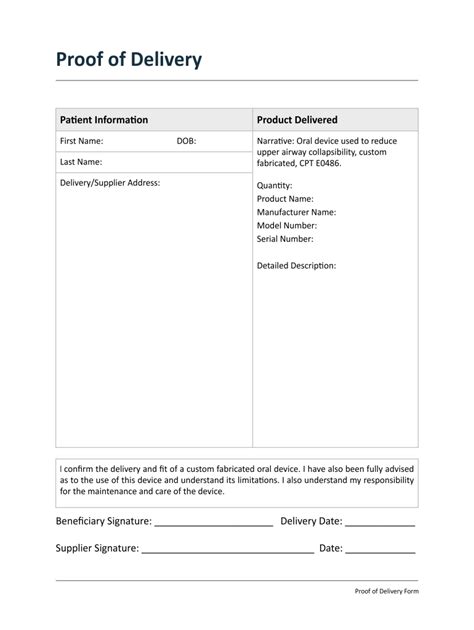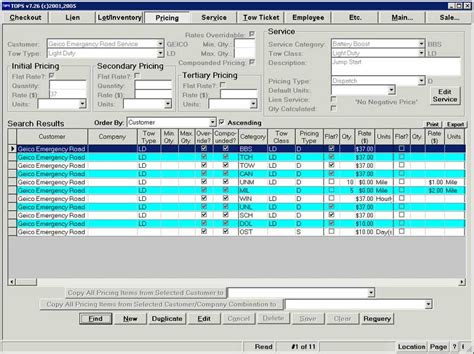Proof Of Delivery Document

The Proof of Delivery (POD) document is a critical element in the logistics and supply chain industry, serving as an essential proof of transaction for both businesses and customers. This legally binding document provides evidence that a delivery has been successfully completed, ensuring that goods have reached their intended destination and providing a transparent record of the delivery process. In today's fast-paced and competitive business environment, the POD document plays a pivotal role in ensuring smooth operations, mitigating risks, and fostering trust among stakeholders.
Understanding the Proof of Delivery Document

The Proof of Delivery document is a comprehensive record of the entire delivery process, capturing key details such as the sender’s and recipient’s information, the date and time of delivery, the signature of the recipient, and often, additional details like the condition of the goods upon delivery. This document is generated by the logistics provider or courier service and is typically presented in a standardized format to ensure consistency and ease of understanding.
The primary purpose of the POD is to provide irrefutable evidence of the completion of a delivery, offering legal protection to all parties involved. It serves as a critical tool for dispute resolution, enabling businesses and customers to quickly address any issues related to delivery, such as late arrivals, missing items, or damaged goods. With the POD, all parties can refer to a transparent record of the delivery, ensuring a fair and efficient resolution process.
The Evolution of POD in the Digital Age
Traditionally, POD documents were physical forms that were manually filled out and signed by the recipient upon delivery. However, with the advent of digital technologies, the POD has undergone a significant transformation, becoming more streamlined, efficient, and accessible. Today, many logistics companies utilize digital PODs, which can be signed electronically and are instantly available in real-time, eliminating the need for physical paperwork and significantly reducing the risk of errors and delays.
Digital PODs not only improve efficiency but also enhance the overall customer experience. With real-time updates, customers can track their deliveries more accurately and receive instant notifications upon successful delivery. This level of transparency and immediacy fosters trust and satisfaction, which are crucial for building long-term customer relationships.
| Digital POD Benefits | Traditional POD Challenges |
|---|---|
| Real-time tracking and notifications | Delays in updating physical records |
| Enhanced security and data protection | Risk of loss, damage, or forgery of physical documents |
| Improved accuracy and reduced errors | Manual entry errors and inconsistencies |

Key Components of a Comprehensive POD

A well-designed Proof of Delivery document should encompass a range of critical details to ensure its effectiveness and legal validity. Here are some key components that should be included in every POD:
Sender and Recipient Information
The POD should clearly display the names and contact details of both the sender and the recipient. This information is essential for verifying the authenticity of the transaction and for ensuring that the correct parties are involved in the delivery process.
Date and Time of Delivery
The exact date and time of delivery are crucial elements of the POD. This information provides a precise record of when the delivery was completed, which is vital for dispute resolution and for ensuring timely deliveries. Many digital POD systems offer automatic time-stamping features, eliminating the need for manual entry and reducing the risk of errors.
Signature of the Recipient
The signature of the recipient is arguably the most critical aspect of the POD. It serves as a legally binding acknowledgment that the goods have been received and accepted. In the case of digital PODs, electronic signatures are used, which carry the same legal weight as traditional handwritten signatures.
Additional Details: Condition of Goods and Special Instructions
Beyond the basic information, a comprehensive POD may also include details about the condition of the goods upon delivery. This can include notes on any damage, missing items, or special instructions provided by the sender. Such details can be invaluable for addressing any issues promptly and efficiently.
The Impact of POD on Logistics Operations
The Proof of Delivery document has a profound impact on the overall efficiency and effectiveness of logistics operations. By providing a transparent and accurate record of deliveries, PODs enable logistics companies to:
- Improve delivery accuracy and reduce errors.
- Enhance customer satisfaction by providing real-time delivery updates.
- Streamline the dispute resolution process, reducing the time and resources required to address delivery-related issues.
- Build trust and credibility with customers and partners, fostering long-term relationships.
- Optimize fleet management by providing real-time delivery data for more efficient route planning.
Furthermore, PODs play a critical role in risk management for logistics companies. With detailed records of deliveries, companies can quickly identify and address any potential issues, such as late deliveries, missing items, or damaged goods. This proactive approach to risk management not only protects the company's reputation but also helps to maintain a positive relationship with customers and partners.
Future Trends and Innovations in POD
As technology continues to advance, the Proof of Delivery document is likely to evolve further, offering even greater efficiency and security. Here are some future trends and innovations that are expected to shape the POD landscape:
Blockchain Technology
The integration of blockchain technology into POD systems could revolutionize the way deliveries are verified. Blockchain’s decentralized and immutable nature would ensure that POD data is secure, transparent, and tamper-proof. This would enhance the credibility of PODs and further streamline the dispute resolution process.
Artificial Intelligence and Machine Learning
AI and ML technologies can be leveraged to automate various aspects of the POD process, such as signature verification and data extraction. These technologies can also be used to analyze delivery patterns and identify potential risks or inefficiencies, enabling logistics companies to optimize their operations.
Enhanced Security Features
With the increasing focus on data security, future POD systems are likely to incorporate advanced security features such as encryption, two-factor authentication, and biometric identification. These measures will ensure that POD data remains secure and accessible only to authorized individuals.
Integration with IoT Devices
The Internet of Things (IoT) has the potential to transform the POD process by enabling real-time tracking and monitoring of deliveries. IoT devices, such as GPS trackers and sensors, can provide accurate location data and condition updates, further enhancing the accuracy and reliability of PODs.
How does a POD protect businesses and customers?
+A POD serves as legal proof of delivery, protecting both businesses and customers. For businesses, it ensures that they have fulfilled their delivery obligations and can claim payment. For customers, it provides evidence that the goods were received and can be used to resolve disputes related to late or incorrect deliveries.
What happens if a recipient refuses to sign the POD?
+If a recipient refuses to sign the POD, the delivery driver should make a note of this on the document, indicating that the recipient refused to sign. This documentation can still be used as evidence of a delivery attempt, although it may not be as conclusive as a signed POD.
How can digital PODs improve customer satisfaction?
+Digital PODs can improve customer satisfaction by providing real-time updates and notifications upon successful delivery. Customers can track their deliveries in real-time and receive instant confirmation when their goods have been received, enhancing the overall delivery experience.
What security measures are in place for digital PODs?
+Digital POD systems typically employ robust security measures such as encryption, two-factor authentication, and secure data storage. These measures ensure that POD data is protected from unauthorized access and tampering, maintaining the integrity of the delivery record.
In conclusion, the Proof of Delivery document is a critical component of the logistics industry, providing legal proof of transaction and fostering trust among stakeholders. With the digital evolution of PODs, logistics companies can offer more efficient, secure, and transparent services, meeting the evolving expectations of modern consumers. As technology continues to advance, the future of PODs looks promising, with potential innovations such as blockchain, AI, and IoT integration, further enhancing the delivery experience and risk management capabilities of logistics companies.

